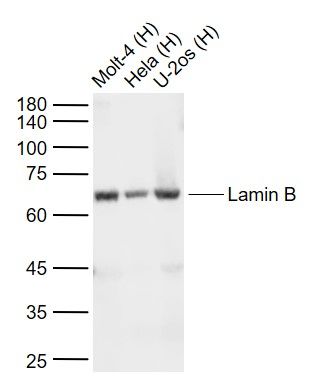The nuclear lamina consists of a two-dimensional matrix of proteins located next to the inner nuclear membrane. The lamin family of proteins make up the matrix and are highly conserved in evolution. During mitosis, the lamina matrix is reversibly disassembled as the lamin proteins are phosphorylated. Lamin proteins are thought to be involved in nuclear stability, chromatin structure and gene expression. Vertebrate lamins consist of two types, A and B. This gene encodes one of the two B type proteins, B1. Alternative splicing results in transcript variants and a duplication of this gene is associated with autosomal dominant adult-onset leukodystrophy (ADLD). [provided by RefSeq, Oct 2010].
Function:
Lamins are components of the nuclear lamina, a fibrous layer on the nucleoplasmic side of the inner nuclear membrane, which is thought to provide a framework for the nuclear envelope and may also interact with chromatin
Subunit:
Homodimer. Interacts with lamin-associated polypeptides IA, IB and 2.
Subcellular Location:
Nucleus inner membrane; Lipid-anchor; Nucleoplasmic side
Post-translational modifications:
B-type lamins undergo a series of modifications, such as farnesylation and phosphorylation. Increased phosphorylation of the lamins occurs before envelope disintegration and probably plays a role in regulating lamin associations.
DISEASE:
Defects in LMNB1 are the cause of leukodystrophy demyelinating autosomal dominant adult-onset (ADLD) [MIM:169500]. ADLD is a slowly progressive and fatal demyelinating leukodystrophy, presenting in the fourth or fifth decade of life. Clinically characterized by early autonomic abnormalities, pyramidal and cerebellar dysfunction, and symmetric demyelination of the CNS. It differs from multiple sclerosis and other demyelinating disorders in that neuropathology shows preservation of oligodendroglia in the presence of subtotal demyelination and lack of astrogliosis.
Similarity:
Belongs to the intermediate filament family.
SWISS:
P20700
Gene ID:
4001
Database links:
Entrez Gene: 396223 Chicken
Entrez Gene: 4001 Human
Entrez Gene: 16906 Mouse
Entrez Gene: 116685 Rat
Omim: 150340 Human
SwissProt: P14731 Chicken
SwissProt: P20700 Human
SwissProt: P14733 Mouse
SwissProt: P70615 Rat
Unigene: 89497 Human
Unigene: 4105 Mouse
Unigene: 11362 Rat
| Picture |
Sample:
Lane 1: Human Molt-4 cell lysates
Lane 2: Human Hela cell lysates
Lane 3: Human U-2os cell ysates
Primary: Anti-Lamin B (SLM33442M) at 1/1000 dilution
Secondary: IRDye800CW Goat Anti-Mouse IgG at 1/20000 dilution
Predicted band size: 64 kDa
Observed band size: 64 kDa
|
|
|
